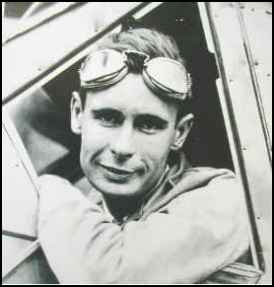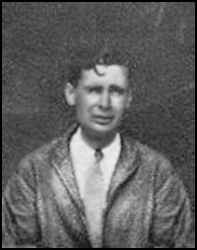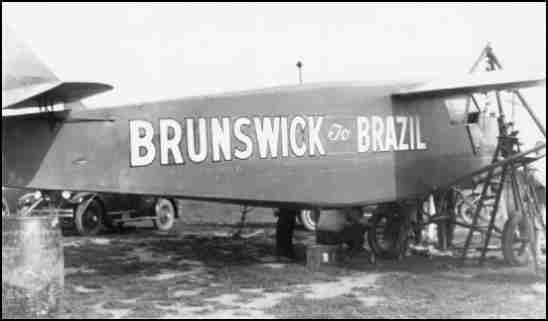

1902-1927 |
 |
 |
|
Photo Courtesy of Ron Shelton |
Photo Courtesy of Ron Shelton |
 |
|
(Russell Maxey Collection) Photo Courtesy of Cap'n Billy |
 |
|
Courtesy of Roy Nagl Ancient Aviators Website |
|
Whatever became of Zelda? By Bill Foley, Times-Union columnist The Florida Times-Union Sunday, August 23, 1998 The civilized world was agog over flight the summer of 1927. Jacksonville was a-twitter over Paul R. Redfern. Charles A. Lindbergh had soloed the Atlantic in May and become the most famous human in the galaxy. Paul Redfern was going to fly to Rio and do Lindy one better. The whole planet knew Lindbergh's Spirit of St. Louis. Redfern was going to make posterity remember the Port of Brunswick. That was the name of the plane Redfern was going to fly from Georgia to Brazil, to break every distance and endurance record in the sky. This would be the most daring flight yet undertaken, in a time when heart-tripping headlines of aviation adventure daily thrilled the nation. It would be 4,600 miles over open sea, dense jungle and daunting mountain; tiny man in a green and gold monoplane hurtling into the infinite maw of adventure. The Brunswick chamber of commerce put up $25,000 for Redfern's flight; the same amount Lindbergh chased over the sea. Redfern was 27 and full of sass and vinegar. He weighed about 110 pounds, had barnstormed in 40 states and once busted 80 stills in a week as an airborne revenue agent. He had been jailed in Texas for buzzing a railroad car and in South Carolina for dropping a football dummy from 2,000 feet, which caused widespread fainting at an air show. Once he took the ''world's smallest flying machine'' on a national advertising tour. Jacksonville already was flight-bit and ready for Redfern. Lindbergh was coming in October. The town was going toname its airport for him. What better than to have a just-down-the-road hometown hero to meet him? So moved by Redfern's adventure was Jacksonville's Zelda O. Clarke that she offered to go along. The Jacksonville Journal of July 12, 1927, broached her offer: ''If Paul R. Redfern wants a woman to accompany him on his non-stop flight from Brunswick to Rio de Janeiro, all he has to do is say yes to Miss Zelda O. Clarke, 1130 Rosselle St., Jacksonville, Fla.,'' The Associated Press reported. ''Through the Brunswick Board of Trade, Miss Clarke today put in the first bid to accompany him on his trip. 'I know nothing of aviation,' she said in her letter, 'Could be of no assistance to him, but I want to help Georgia and Florida win fame and am anxious to accompany him.' '' At the time, this hardly was an odd aspiration. Women had thrust boldly into aviation. The woman-in-a-cabin ploy was gaining currency. Princess Lowenstein-Wertheim of Great Britain even then was bankrolling a flight in which she would be the first woman to fly the ocean. (The plane was lost at sea.) Lakeland's Ruth Elder, the Flying Flapper, and George Haldeman, forever linked with Jacksonville, would plop The American Girl 350 miles from Spain in October. Amelia Earhart would become famous for riding over the sea the next year in a plane flown by Wilmer Stultz and Slim Gordon, who never quite became household words. So, Zelda had not so wild a dream. Lucky for her, sad for her fame, Redfern didn't buy it. He was alone in the six-passenger Stinson Detroiter that Thursday morning when he took off from the beach at Glynn Isle, ''Brunswick to Brazil'' boldly painted on the side of his plane, a box lunch packed by his wife at his side. Don't worry if you don't hear from me for six months, Redfern remarked quite curiously to his friends, haunting words they would ponder in the tortured days, months and years ahead. For Paul Redfern flew from Glynn Isle, over a shrimp boat fleet out to the Atlantic and off the face of the Earth. An anxious world waited in vain with tension and then despair to hear again of Paul Redfern and the Port of Brunswick. In time, ships and planes searched the sea. Expeditions combed the jungle. Friends said he'd come out of it with a corking good tale, but faint hope flickered and then all but vanished. Word would come forth now and then of a white man living in the jungle, of a mysterious stranger who could be Redfern seen hither and yon. But of the corporeal barnstormer nothing again would be realized. After 10 years, in 1937 - the year Amelia Earhart disappeared - Redfern's wife petitioned to have him declared dead. For a full decade the disappearance of Paul Redfern was the paramount mystery of flight. Then Earhart was lost and in the commotion over her legend the memory of the wiry little adventurer from just down the road receded into the mists of the history, all but beyond the pale of memory. Fame is fleeting. Even mystery is relative. Like, whatever happened to Zelda? |
|
He built and soloed in a biplane glider in 1914. That same year he built and flew over 100 flights in a monoplane of his own design. He is perhaps best known for his attempts to rescue Paul Redfern from the jungles of South America. On one flight he located an unfriendly Indian tribe that had water cans that appeared to be part of Redfern's equipment. He brought back pictures of the Indians and maps of the territory where he thought Redfern might have been captured. He is survived by his wife, Helen, who lives in Oakland, California, a son and one grandchild. January 1973, Number 79 |
|
|
|
By Thomas Savage and Ron Shelton "Paul Rinaldo Redfern -----The First Aviator to Solo the Caribbean Sea At age 16 he built and flew in a biplane type glider on the outskirts of Columbia, S. C. In a sophomore industrial arts class at Columbia High School he built a full size biplane without an engine. It created a local sensation when displayed at the University of South Carolina, and resulted in his not graduating the following year with his senior class. Because of his demonstrated skills and talent and with his parents’ permission he left the area upon the completion of his second year in high school to work as an inspector at the Standard Aircraft Factory in Elizabeth, New Jersey. When the factory ceased production in February, 1919 he reentered high school in Columbia." (Continued) This excerpt from the introduction to the definitive online biography of Paul Redfern is taken from a really superb six page article which may be found on the Cap'n Billy website. It is very comprehensive with many beautiful photographs and can be enjoyed by clicking on the title New Addition
Thought you’d like to know that we had a small commemoration of Redfern’s flight last month, and the
story is on my home page. You can reach it by clicking on:9-14-08 |
|
By Becky Bailey |
|
|


|